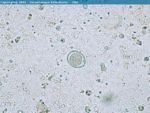Difference between revisions of "Coccidiosis - Dog"
Jump to navigation
Jump to search
| Line 8: | Line 8: | ||
*Even if faecal oocyst count is high, other causes of [[Diarrhoea|diarrhoea]] should be looked for | *Even if faecal oocyst count is high, other causes of [[Diarrhoea|diarrhoea]] should be looked for | ||
| − | *''Hepatozoon americanum'' and subclinical ''H. canis'' in [[ | + | *''Hepatozoon americanum'' and subclinical ''H. canis'' in [[Hepatozoon|periosteal bone formation]] |
**Both are Tick borne diseases | **Both are Tick borne diseases | ||
***''H. canis'' – ''Rhipicephalus sanguineus'' | ***''H. canis'' – ''Rhipicephalus sanguineus'' | ||
Revision as of 13:21, 3 March 2011
- 2 common and 2 less common Isospora species
- Occasionally can cause disease
- Little pathogenicity
- Even if faecal oocyst count is high, other causes of diarrhoea should be looked for
- Hepatozoon americanum and subclinical H. canis in periosteal bone formation
- Both are Tick borne diseases
- H. canis – Rhipicephalus sanguineus
- Ticks become infected by ingesting a blood meal containing macrophages and neutrophils infected with the parasite gamonts -> sexual replication in the gut of the tick -> oocysts containing infective sporozoites -> dogs ingest the tick schizogony occurs in numerous tissues
- Both are Tick borne diseases
[[Category:Dog]
